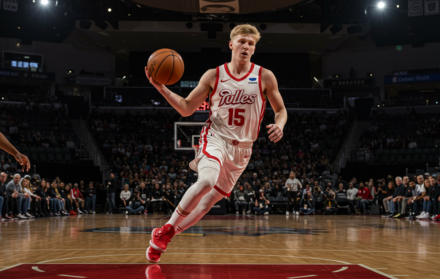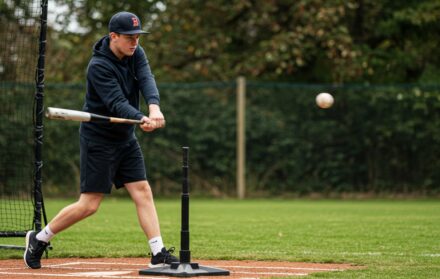
From Beginner to Advanced: Progressive Hitting Drills for All Levels
Hitting in baseball might look effortless when you watch a professional launch a ball over the fence, but that smooth power and precision come from an ongoing process of refining mechanics, timing, and mental approach. Regardless of whether you’re just beginning or have several seasons under your belt, focusing on progressive hitting drills for all levels helps maintain a steady upward trajectory in your game. These drills are designed to meet you where you are and push you gradually toward more complex techniques. By layering fundamental skills in a systematic way, hitters gain a deeper understanding of their swing, build confidence, and ultimately drive the ball with greater authority.
This article aims to offer a roadmap for hitters of diverse experience—beginner, intermediate, and advanced. Instead of a random assortment of drills, we’ll walk through stages that logically build upon each other, addressing technical adjustments, mental approaches, and situational hitting. Whether you’re picking up a bat for the first time or looking to add power and consistency to an already robust swing, these progressive steps can accelerate your improvement. And since baseball is as much mental as it is physical, we’ll also explore how each drill fosters better pitch recognition, timing, and overall plate discipline. By combining structured exercises with real-time feedback—either from a coach, a teammate, or your own video analysis—you’ll see how each practice session can become a leap forward, not just a routine.
Mastering the Basics: Establishing a Solid Stance and Grip

Every hitter’s journey starts with a stable foundation—your stance and grip. Even professionals return to these basics when slumps or mechanical issues creep in. A balanced stance, with feet shoulder-width apart and weight slightly on the balls of your feet, allows for fluid, powerful movements. Knees bent just enough to keep your body athletic and ready to react. Meanwhile, your grip is pivotal: hold the bat too tight and your swing stiffens; too loose, and you sacrifice bat control.
For novices, the first “drill” often isn’t a real swing at all: it’s standing in a mirror or in the batter’s box, focusing on posture, bat angle, and comfort. This might sound elementary, but spending ten minutes ensuring your feet, hips, and shoulders align can preempt bad habits that derail future progress. If your stance drifts open or closed, you risk limiting your swing’s effectiveness. Similarly, check your hand position on the bat. Overlapping grips vary from player to player, but the core principle is consistency—knowing exactly how the bat rests in your hands each time fosters a repeatable swing path.
Once comfortable, introduce a simple drill: the “dry swing.” Without a ball, replicate your swing motion at slow speed, focusing on maintaining balance throughout. Feel how your weight shifts from the back foot to the front foot, and pay attention to the angle of the barrel. New players often discover that doing even half a dozen slow-motion swings reveals flaws—like over-rotating hips or lifting the head early. By capturing this on video or receiving immediate feedback from a coach, you lay the groundwork for more advanced drills in the future.
Moreover, beginners should practice forming a “launch position,” the moment just before you fire your swing at the pitch. This position typically features a slight coil in the hips, hands near the back shoulder, and eyes locked on the imaginary pitch location. Getting to the same launch spot consistently is a hallmark of hitters who develop good timing. Over time, as your stance and grip become second nature, you’ll free up mental energy to focus on pitch recognition and strategic hitting.
Stage One Drills: Batting Tee and Basic Front Toss
When your stance and grip feel comfortable, you’re ready to introduce a ball and start building core hitting mechanics. The batting tee remains an underrated ally for hitters of every level. At the beginner stage, it strips away the complexity of varying pitch speeds or movement, letting you focus purely on swing path and contact point. Place the tee at belt height, lining it up with the center of home plate for a neutral pitch location. Start by hitting 10-15 balls, checking that each swing meets the ball squarely while your head remains down.
Over sessions, vary tee placement: move it inside to practice pulling the ball, and move it outside to work on going the other way. Lower or raise the tee to simulate different pitch heights. The simplicity of the tee reveals whether your swing plane adjusts properly for each location. If you consistently jam yourself on inside tee placement, you’ll know you must open your hips or get the barrel through quicker.
After you develop some consistency with the tee, progress to basic front toss. A partner or coach stands a short distance (about 10-15 feet) in front, gently lobbing the ball underhand. The speed is still modest, but the ball’s movement demands timing. Focus on repeating the same swing mechanics from tee work, with an added element of timing. Intermediate variations include mixing speeds slightly, tossing balls at different heights, or occasionally feeding a pitch outside your comfort zone. You might track how many solid line drives you make out of 10 tosses, building a mental library of your success rate. Over time, once you’re consistently barreling up front toss, you’re ready for faster speeds or more complex drills.
Introducing Live Arm and Soft Toss Variations
Once you’re comfortable with front toss, the next progression typically involves either soft toss from the side or a live arm from a moderate distance. Soft toss from the side challenges you with different angles, forcing you to adjust your stride and swing path as the ball arrives from a diagonal position. The gentle arc remains manageable, but you gain practice in reading ball trajectory from an unusual origin. This fosters quicker decision-making and helps you refine your bat path for different pitch locations.
Live arm toss from a short distance—whether overhand or sidearm—ramps up the realism. Speeds can remain moderate, but the visual cues of an actual throwing motion sharpen your pitch recognition. Beginners often realize that their timing, flawless against a tee or front toss, becomes erratic when facing even a casual pitcher’s windup. Embrace the mistakes as data points: you might be starting your load too late or striding too far. Each session of live arm toss is a laboratory for diagnosing these minor mechanical or timing issues. If you maintain focus on replicating your stance, stride, and swing each time, you’ll develop consistency that scales to faster pitching.
Soft toss or live arm sessions allow for situational hitting as well. For instance, set a goal of hitting grounders to the right side to simulate moving a runner. Or practice driving the ball to the outfield as if you need a sacrifice fly. These tasks introduce mental elements—pitch recognition, strategic shot placement—that intertwine with the mechanical progress you’re making. And at this stage, you’re likely noticing how comfort at the tee and in simple front toss sets you up for success in these more dynamic drills, embodying the principle of progressive skill-building.
Developing Better Bat Speed and Contact Consistency

As you move from a pure beginner toward more advanced hitting, two metrics often come to the forefront: bat speed and contact consistency. Bat speed influences how hard you can drive the ball, but wild flailing with a fast swing doesn’t yield results if you’re not making clean contact. The interplay of speed and precision demands specialized drills. One effective approach is to interleave “slow and fast” swing sessions. After a few strong, full-intensity swings, dial back to a more controlled tempo for the next few pitches. This toggling trains you to maintain fundamental mechanics even when you ramp up the power.
Another staple is the “two-tee drill.” You place two tees at different heights—one slightly ahead of the other—forcing you to adapt mid-swing. The objective might be hitting a low pitch followed by a higher one, or an inside pitch followed by an outside pitch. This multi-contact approach hones quick barrel adjustments and fosters hand-eye coordination. If you find yourself failing to square up the second ball, you can slow down your swing, focusing on technique over force, then gradually reintroduce speed.
Additionally, heavier bat practice can temporarily increase bat speed. Swinging a slightly heavier bat (or using a bat weight) for a few reps primes your muscles, so when you return to your usual bat, it feels lighter, enabling faster swings. However, do this in moderation to avoid messing up your timing or straining your arms. End each session swinging your regular game bat to reinforce the muscle memory for live at-bats. Over weeks of consistently applying these drills, you’ll see your exit velocity climb alongside your capacity to consistently find the barrel.
Intermediate to Advanced Drills: Machine Work and Varying Speeds
Once comfortable with moderate live pitching, it’s time to challenge your reflexes and adaptability at higher velocities or more diverse pitch movement. A pitching machine becomes invaluable here, especially if you can dial in speeds that push your limits. Set the machine to a fastball speed slightly above what you’ve faced before. Early on, you might whiff or foul off, but repeated exposure forces your brain and muscles to sync at faster reaction times. Keep returning to your stance and load fundamentals. If you overswing in panic, revert to a calm approach, letting the improved bat speed from earlier drills do the work.
To incorporate variability, some machines allow random pitch settings. You won’t know if the next pitch will be high, low, inside, or outside. This unpredictability mimics real game scenarios, prompting you to read the ball’s flight from release. Another layer is introducing off-speed or breaking-ball settings if the machine supports it. Even if the break is artificial, seeing different trajectories develops advanced pitch recognition. Each time, you strive to maintain the same mechanical foundation—stance, load, stride, swing path—while adjusting your timing. Over multiple sessions, what initially seems chaotic becomes manageable, indicating real progress in reading the ball early.
For hitters with consistent machine access, segment your session into “velocity blocks.” For 10 pitches, keep it at a demanding speed, focusing on contact. Then drop the speed for a few pitches, reinforcing form. Then ramp it back up. This wave-like pattern prevents mental fatigue while still building reflexes. If you find a sweet spot where you’re squaring up pitches consistently, nudge the speed higher. The aim is to keep yourself in that zone of “difficult but achievable,” fueling adaptation.
Polishing Plate Discipline and Pitch Selection
Hitting isn’t just about mechanical prowess; it’s also about deciding which pitches to swing at and which to let pass. Even with a beautiful swing, chasing outside pitches undercuts your success. To address plate discipline, incorporate “take or swing” drills where a partner or coach calls out “swing” or “take” mid-flight or holds up visual signals. You must respond quickly—if you see a green signal, you swing; if it’s red, you lay off. This fosters the quick mental shift crucial in real at-bats, distinguishing borderline pitches from hittable ones.
Another angle is situational awareness. Use colored balls—some white, some yellow, for instance—and only swing if it’s the white ball. The partner alternates them unpredictably. You gain practice in visually screening the ball type, akin to reading the spin or color of the seams in advanced play. The mental load of color recognition parallels how batters must identify spin direction or seam orientation. Over time, these exercises sharpen your “swing decision,” layering on top of your improving swing mechanics.
When transitioning from intermediate to advanced, you’ll find that selecting the right pitch to drive is as pivotal as having the skill to drive it. Freed from the burden of chasing everything, advanced hitters can zero in on their hot zones. This refined approach not only boosts batting average but also elevates on-base percentage. Practices become more mentally engaging, with each pitch an opportunity to practice discipline or aggression, mirroring game situations where a single ill-chosen swing can ruin an at-bat.
Advanced Mental Approaches and Game-Ready Simulations

For high-level players or those aspiring to reach that tier, bridging the gap between mechanical drills and game performance hinges on mental fortitude. Once you have the consistent swing and refined pitch selection, you face psychological challenges like hitting under pressure, working out of slumps, or facing elite pitching. Drills that incorporate game-like situations—e.g., imagining a 2-2 count, or needing a sacrifice fly with a runner on third—force your mind into problem-solving mode. In each scenario, you must choose swing aggression or restraint while still executing proper mechanics.
One popular approach is “situational batting practice.” Have a coach or partner call out the scenario before each pitch: tie game, runner on second, one out. Your job: either move the runner or drive them in. They might instruct you to lay off low pitches or inside corners, focusing on hitting the ball to the right side. This element of strategy demands you remain calm under constraints, merging your refined footwork, bat speed, and pitch selection skills. Repetition of these vignettes fosters readiness for real games, where distractions and pressure abound.
Moreover, players nearing advanced levels often study pitchers. You can replicate certain pitch types or sequences if you know an upcoming opponent’s tendencies. For instance, if a particular pitcher likes to follow a high fastball with a slider in the dirt, simulate that pattern in batting practice. The mental preparation—anticipating the slider break while resisting the temptation to chase—sharpens your reaction. Over time, you’ll internalize a balanced approach: swift mechanical responses fused with a calm, strategic mind.
Overcoming Plateaus and Sustaining Growth
Even with structured progression, hitters sometimes hit plateaus where improvement stalls. This can stem from mechanical habits, mental burnout, or physical fatigue. To combat plateaus, rotate your focus periodically. If you’ve spent weeks zeroing in on line-drive contact, maybe shift to power-driven drills or vise versa. Sometimes, returning to simpler drills—like the batting tee—unearths subtle mechanical leaks that escaped notice in high-velocity sessions. Video analysis can help pinpoint if your stance has drifted or your back elbow is dropping.
Another tactic is cross-training. Hand-eye coordination exercises from other sports—racquet sports, for example—can refine your hitting skills indirectly. A short tennis rally hones reflexes and spatial awareness, which translate back into the batter’s box. Similarly, strength and flexibility routines bolster your capacity for high-intensity swings without risking injury. If you find your upper-body tension creeping in, yoga or dynamic stretching might restore fluidity.
Most importantly, remain patient yet persistent. Baseball hitting is notoriously streaky; even top-level pros endure slumps. Recognize these dips as normal. By leaning on the drills and progressions that carried you from beginner to advanced, you can reestablish your foundational mechanics and build momentum again. The cyclical nature of refining your stance, timing, and mental clarity ensures that each slump is just a detour, not a dead end.
Conclusion: Continual Evolution Through Progressive Hitting Drills for All Levels

The path from novice to advanced hitter isn’t a straight line. It winds through stages of basic stance work, controlled tee drills, front toss routines, medium-paced live pitching, and eventually, the daunting speeds and cunning pitch types of elite opponents. Every hitter’s progression is unique, shaped by natural aptitude, coaching quality, and dedication. Yet the principles behind progressive hitting drills for all levels stay universal: begin with rock-solid fundamentals, layer on incremental challenges, and never neglect the mental side of hitting.
At each phase, consistency is the glue. Whether you’re perfecting your stance in front of a mirror or preparing to face a 90 mph fastball, each session should focus on repeatable mechanics and situational awareness. Mistakes, rather than sources of frustration, become invaluable feedback loops that guide small adjustments. Plate discipline merges seamlessly with physical technique, producing a hitter who not only squares up the ball but also knows when to swing and when to hold back.
Ultimately, progressive drills don’t just help you hit the ball harder or more frequently—they help you become a complete hitter who can adapt to any count, pitch type, or in-game situation. By steadily boosting your comfort zone, you’ll find that once-daunting speeds or nasty breaking pitches become manageable. Most crucially, this growth extends beyond any single season or age bracket. A hitter trained in progressive methodology can recalibrate even decades later, returning to foundational drills to correct issues. In baseball, as in life, evolution never ends. By embracing and regularly revisiting these staged drills, you fortify your swing for the long haul, ensuring that each time you step into the batter’s box, you do so as a more refined, confident, and impactful hitter.





